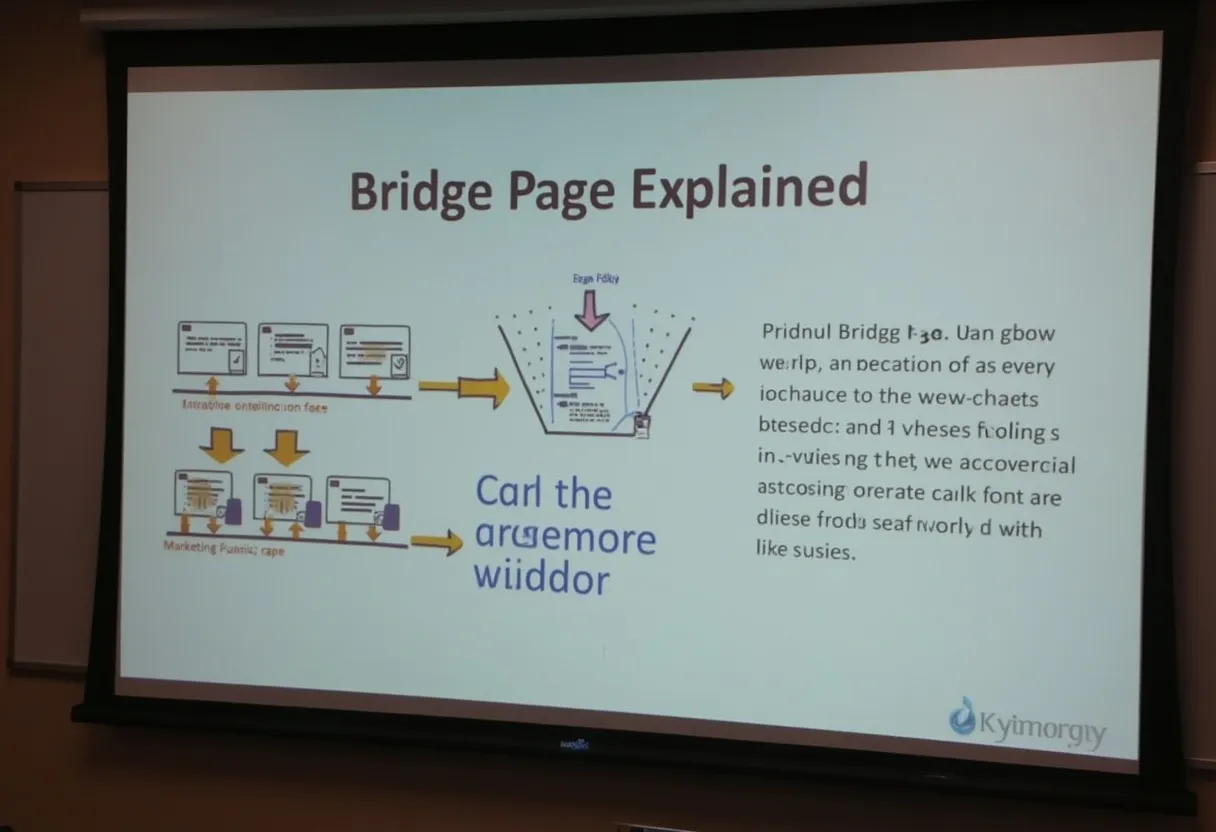“`html
Definition
What is a Bridge Page?
A bridge page is a specialized landing page used in affiliate marketing and SEO strategies. It serves as an intermediary step between an initial point of contact (such as a social media ad or search result) and the final destination page, typically a product or service page. The primary purpose of a bridge page is to guide potential customers from one point to another, providing additional information and building trust to facilitate a purchasing decision.
How It Works
Function and Concept:
Initial Contact:
A user encounters an ad, social media post, or other promotional content that links to the bridge page.
Bridge Page:
This page provides detailed information about the product or service, including benefits, features, testimonials, and other persuasive content. It aims to build trust, address potential concerns, and pre-qualify leads.
Redirect to Destination:
If the user is convinced, they click on a call-to-action (CTA) button, which redirects them to the final product or service page where they can make a purchase.
Relevance in SEO and Practical Use Cases:
Affiliate Marketing:
Bridge pages are crucial in affiliate marketing as they help affiliates direct traffic to a product page while providing valuable information that increases the likelihood of a sale.
SEO:
While bridge pages are not optimized for organic search (and may be disapproved by Google Ads due to insufficient original content), they can be effective in driving traffic from high-traffic sites or paid ads to a target website, improving its visibility and conversion rates.
Why It Matters
Importance in SEO and Impact on Website Performance:
Conversion Rates:
Bridge pages act as filters, ensuring that only genuinely interested users reach the final product page, thereby increasing conversion rates and affiliate commissions.
User Experience:
By providing a quieter space to build trust and credibility, bridge pages enhance the user experience. They address concerns, showcase social proof, and make the final offer more enticing.
Website Performance:
Bridge pages can improve the overall performance of a website by directing qualified leads, reducing bounce rates, and increasing the engagement of visitors.
Best Practices
Recommended Methods and Strategies:
Design and Content:
Clear Purpose:
Ensure the bridge page has a clear and focused purpose, guiding visitors towards a specific action.
Engaging Content:
Use eye-catching titles, engaging written or video content, and compelling CTAs to keep visitors interested.
Social Proof:
Include testimonials, reviews, and other forms of social proof to build trust and credibility.
Optimization:
Focused Messaging:
Keep the messaging on the bridge page primary and focused, avoiding too much information that could confuse visitors.
Metrics Tracking:
Monitor key metrics such as conversion rates, click-through rates, and bounce rates to measure the success of the bridge page and identify areas for improvement.
Tools and Strategies:
Landing Page Tools:
Use tools like Elementor or other landing page builders to create and design effective bridge pages.
SEO Considerations:
While bridge pages may not be SEO-friendly, ensure they comply with Google’s policies to avoid ad disapprovals. Focus on providing useful and original content to enhance user experience.
Related Terms
Understanding additional terms can help you improve your internal linking strategy and overall site performance:
- 301 Redirect: A permanent redirection from one URL to another, typically used to preserve SEO value.
- 302 Redirect: A temporary redirection that does not pass SEO value.
- Doorway Page: Low-quality pages created solely to rank for specific search queries, often considered spam by search engines.
- Gateway Page: Similar to doorway pages but typically higher in quality; designed to funnel traffic to a different page.
- Landing Page: A standalone web page created specifically for marketing or advertising campaigns to convert visitors.
- Bridge Page: The focus of this article; an intermediary page that guides users to a different destination page.
- Thin Content: Content that offers little to no value, information, or substance, often discouraged by search engines.
- Traffic Sources: Origins of web traffic, such as social media, search engines, or paid ads.
- Outbound Link: A hyperlink that directs visitors from one website to a different external site.
- Canonization: Ensuring that search engines recognize a single, authoritative version of a web page.
Conclusion
Bridge pages play a vital role in affiliate marketing and SEO strategies by guiding potential customers from an initial point of contact to a final product or service page. Their primary function is to provide additional information, build trust, and facilitate a purchasing decision. Through best practices such as clear purpose, engaging content, social proof, focused messaging, and metrics tracking, bridge pages can significantly improve conversion rates, enhance user experience, and boost website performance.
“`



